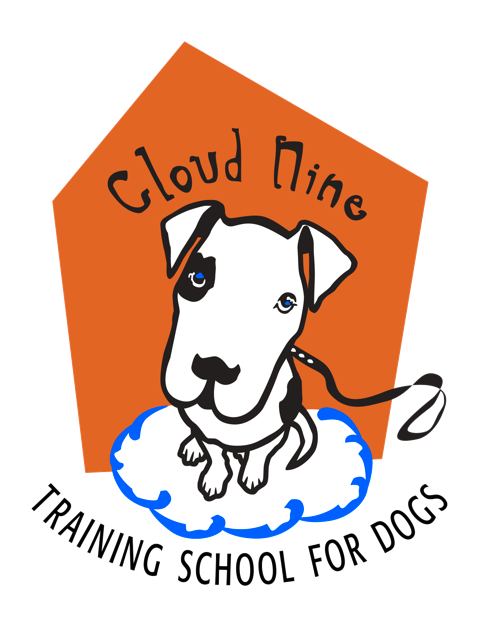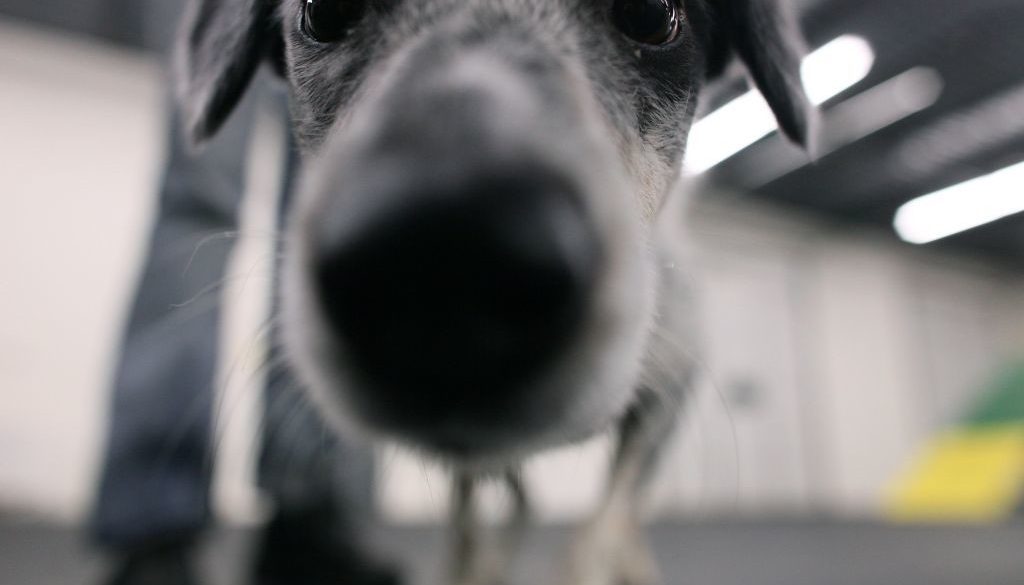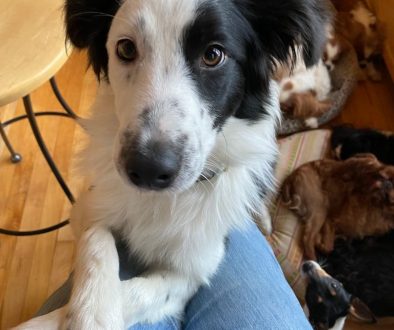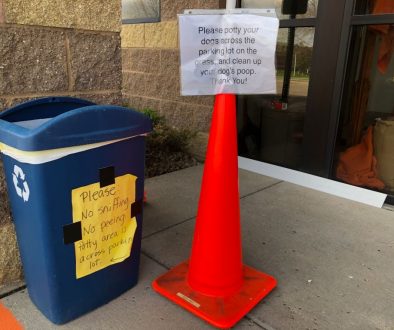The dog’s nose and scenting ability are impressive to say the least.
Here are some facts from Bruce Fogle’s book, The Dog’s Mind – Understanding Your Dog’s Behavior:
1) The average dog has around 220 million scent receptors in his nose; we have around five million.
2) The average dog has about seven square meters of nasal membrane; we have about half a meter.
3) The average dog has such acutely sensitive scenting ability that it can detect and identify smells that are so diluted that even the most sensitive of scientific instruments cannot measure them.
4) Scent is undoubtedly the most important of the dog’s ‘practical’ senses bust also the most difficult for us to comprehend.
Fogle also adds: “Odors have a powerful influence on both the physiology and the behavior of the dog. It’s no exaggeration to say that they are genuinely mind-bending. Smell memories last for life and affect almost all canine behaviors.”The canine’s nose and sense of smell are not to be taken lightly or to be discounted when raising, living with and training your dog. It’s important to remember that when your dog is sniffing in the grass or smelling your shoes or taking in a whiff of air, he is busy, focused!
He’s intent on gathering and processing information and it’s a serious, important, and all-consuming job! So you can see why sometimes you have to work hard to get his attention, why you need to dig deep into your training tool box for the best rewards and motivators (a FUN toy, a to-die-for treat), and why you need to pull out all the stops to build that solid, safe, trusting and reliable relationship between you and your dog so you have a shot at competing with his sense of smell. While many of things we do with our dogs require that they sniff around the environment on a limited basis or not at all (obedience, agility, therapy dog work, going for a walk without checking out every fire hydrant), there are some activities where sniffing, smelling, scenting – using his nose – is the only way to get the job done. And when you introduce your dog to those “nose games” you will be in awe of his “nose” abilities and he no doubt will think: FINALLY!
Barn HuntIng
The game of Barn Hunt, the dog must use his nose to find a rat. The rat (well-cared for, if not pampered) is in a protective PVC tube that is hidden among bales of straw in a contained area. The dog has to learn to find the concealed tube containing the rat, which can be in, under, on top of, or behind the bales. To make it more challenging and more interesting, there are identical tubes in the ring that are empty or that have only used litter in them – but no rat. The dog has to find the tube – or tubes, depending on the level at which you are training/competing – with the live rat in it. The activity is made harder and more complicated by how the bales are arranged and by how many rats are hidden at any given time. Handlers must train their dogs to find ONLY the tubes containing a rat and ignore the decoys. And then you have to trust your dog and his nose to get the job done. If you can’t imagine how much fun this is for the dogs, come watch or participate in one of the Barn Hunt practices, workshops or trials (rat wranglers are always needed) hosted by Cathy Hoese at our Minnetonka location or check out the official Barn Hunt website. There is no prerequisite for a dog to learn and do Barn Hunt, and it’s suitable for dogs of any breed, age, size. The downside of Barn Hunt is that it requires a fairly elaborate set up, including at least one rat (in a protected container) and anywhere from 20 to 50 bales of straw.
K9 Nose Work
This activity is loved by one and all who try it with their dog. In Nose Work, dogs are taught to search for a scent. At first it’s the scent of a treat (how much fun and how easy is that?); later other scents are introduced such as birch, anise and clove. The key to Nose Work is that the dog learn to actively and enthusiastically search high and low, and in, around, under, behind objects and obstacles. Anything is fair game: boxes, cases, vehicles, dumpsters, furniture – any place that the treat (and later the scent) can be hidden for the dog to find. As with Barn Hunt, Nose Work offers various levels of challenges and difficulty (interior, exterior, vehicles, multiple scents, etc.), so there always is something new for the dog to learn, which keeps it interesting for him. The equipment needed to get started is simple: treats, a leash, a harness, and boxes of all shapes and sizes. Later you also will need a container for the treat and the scents, the scents themselves, and a great imagination for thinking of places to hide the scent. This sport can be done for the pure joy of it, but teams also can participate in competitions and earn Nose Work titles. Again, dogs of any age, size, breed – with a working nose – can enjoy this activity, and it’s a great way to give your dog something to do during the long, cold Minnesota winters when it’s too cold to get exercise outdoors. Check out the official Nose Work website for more information. Also check out thek9nose.com for all the supplies needed to get started in the fun activity of Nose Work.
Tracking
Tracking has been around a long time and for good reason – it’s a fun and challenging sport for dogs and it’s idea for people who enjoy the great outdoors. In tracking, dogs are taught to follow human scent. Someone (you or another person) “lays” a track by walking through a field, a forest, a park, a parking lot, a playground, or a combination/mixture of surfaces, depending on the kind of tracking you are doing. As the person walks, he/she drops “articles” (items such as a glove, a sock, a bandana, a wallet, a tin or plastic container) along the way for the dog to find. With handler in tow at the end of a 20-40 foot line, the dog follows the track, finding the articles that were dropped. The track can be anywhere from 400 to 1,000 yards in length and be one and a half to five hours old. The track must incorporate turns and, as the difficulty increases, it also must go through changes of cover as well as through/past obstacles (a tree, a path, a wooded area, the cross track of another person). The handler cannot see the track so must rely on the dog to get from start to finish and find what’s been dropped. It’s an incredible experience and an incomparable feeling to put that much trust in your dog, your relationship, and your training. The bottom line: it’s fun. All you need to get started in tracking is a dog who likes to sniff, a long line, a tracking harness, treats, items for the dog to find, a good pair of hiking boots, weather-appropriate outdoor clothing and bug spray (yes, ticks, mosquitoes and the like are inevitable, sorry to say). Dogs of any age, breed or mix of breeds can do this activity. The sport of tracking is governed by the American Kennel Club, and dogs can earn AKC tracking titles: TD (Tracking Dog), TDX (Tracking Dog Excellent), TDU (Tracking Dog Urban), VST (Variable Surface Tracking Tracking), CT (Champion Tracker). Before a dog can participate in a tracking test, he must be tracking certified by an AKC tracking judge through a pre-evaluation process.
Search and Rescue
Search and Rescue is another nose/scent-based activity and it’s especially appropriate for high-drive, dogs – even better if they are toy fanatics. In SAR, there are three disciplines: tracking/trailing, area search, human remains detection (HRD). For tracking/trailing, the dog is in a harness with a long line attached. He is taught to follow a human scent, with handler in tow – much like recreational tracking described above. However, instead of finding an article at the end of the track, the dog finds a person. For area search, the dog uses his nose to find someone who is lost. The dog is set free by its handler to search a specific area. When the dog finds the “victim” he either returns to his handler to let it be known that someone was found or he stays with the victim and barks until his handler arrives. For HRD, the dog is taught to find the scent of cadaver and to let his handler know, through a final trained response, when the mission is accomplished. HRD dogs work off leash, and they are taught to stay with the source once they have indicated that they have found it. SAR work is intense and demanding. It involves weekly practice with the team in addition to regular training between practices. A volunteer commitment, being a SAR team member can be quite an investment when you add up the costs of equipment, gas/travel, training (many SAR people attend seminars and workshops all across the country at their own expense), certification, clothing, and gear for both handler and dog. In addition, SAR teams, once both are certified must be available at all hours of the day or night should they be needed for a search. To learn more about this demanding and rewarding option, check out Minnesota K9 Search Specialists, one of the local teams.







